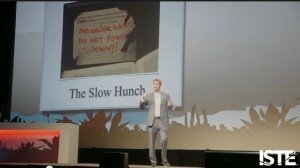Archives
| M | T | W | T | F | S | S |
|---|---|---|---|---|---|---|
| « May | Jul » | |||||
| 1 | 2 | |||||
| 3 | 4 | 5 | 6 | 7 | 8 | 9 |
| 10 | 11 | 12 | 13 | 14 | 15 | 16 |
| 17 | 18 | 19 | 20 | 21 | 22 | 23 |
| 24 | 25 | 26 | 27 | 28 | 29 | 30 |
My Slow Hunch and a Post-ISTE Challenge
 As I reflect on my overall ISTE experience and learning, “What’s next?” keeps percolating to the top of my thoughts. I came to ISTE looking for new ideas and new strategies to share back in my district to move us forward toward the change and enlightenment we all seek for education. I have come to realize that this doesn’t come from a slick new technology, but rather from a creative teacher designing learning to effectively reach every student in his/her charge. Technology can help through the things we can do that weren’t possible without it, but without the teacher’s input – creative design and relationship with students, it might engage students initially, but in the long run, the results won’t change much.
As I reflect on my overall ISTE experience and learning, “What’s next?” keeps percolating to the top of my thoughts. I came to ISTE looking for new ideas and new strategies to share back in my district to move us forward toward the change and enlightenment we all seek for education. I have come to realize that this doesn’t come from a slick new technology, but rather from a creative teacher designing learning to effectively reach every student in his/her charge. Technology can help through the things we can do that weren’t possible without it, but without the teacher’s input – creative design and relationship with students, it might engage students initially, but in the long run, the results won’t change much.
What I continue to come back to in my ISTE experience are some of the ideas shared by Stephen Johnson at his keynote address on Tuesday. He stated:
When ideas take place in a hunch state – they need to collide with other hunches. You have to be able to create a system to allow those hunches to come together and turn in to something bigger than the sum of their parts.
This makes perfect sense to me, and really demonstrates the powerful learning that educators experience via Twitter and other social networks as we exchange ideas and resources to help us make a difference in the lives and learning of our students. I wonder about educators who choose not to participate in the PLN. Do they have a vision and direction to transform learning in their classroom, or are they satisfied with the status-quo? And, I’ve had a nagging thought (or- call it a slow hunch) that as a collective group, we should be making more forward progress and influence as a whole, on the kind of educational reform we seek, which is worlds apart from the reform movement of our nations and states. So what’s missing?
exchange ideas and resources to help us make a difference in the lives and learning of our students. I wonder about educators who choose not to participate in the PLN. Do they have a vision and direction to transform learning in their classroom, or are they satisfied with the status-quo? And, I’ve had a nagging thought (or- call it a slow hunch) that as a collective group, we should be making more forward progress and influence as a whole, on the kind of educational reform we seek, which is worlds apart from the reform movement of our nations and states. So what’s missing?
And then it struck me, as it did during Johnson’s keynote: as connected educators, we have truly been preaching to the choir. Our PLN is wonderful and allows us to individually make changes and move forward in pockets of excellence and innovation, but our collective voice is not being heard.

Photo by Drew McKechnie on http://www.flickr.com
Think about Stephen Johnson’s description of the London coffeehouse and Benjamin Franklin’s Club of Honest Whigs. Johnson said of the successes and ideas born out of that environment that it was due in part to the fact that the coffeehouse was cross-disciplinary in nature. We need to seek out people of diverse backgrounds and opinions to converse with, giving a chance for our slow hunches to collide. We need to expand our sounding board to include people with ideas different from our own.
Wikipedia offers this definition:
Sounding Board : “When a person listens and responds with comments, they provide perspective that otherwise would not be available through introspection or thought alone.”
So with this in mind, I will be taking on the following challenges, and I encourage you to do the same. In the spirit of ISTE’s Connected Learning, Connected World:
- Seek out at least one educator in your district who is not a connected learner. Be a mentor, and listen. Try to discover their perspective, and share yours. If every one of the 20,000 connected educators at ISTE does this, we will significantly expand our pockets of educational innovation.
- Share your passion and vision for transformation in education with at least one non-educator in your community. Seek out opportunities to participate in an environment where diverse perspectives and slow hunches can collide.



